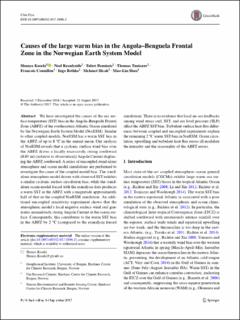| dc.contributor.author | Koseki, Shunya | |
| dc.contributor.author | Keenlyside, Noel | |
| dc.contributor.author | Demissie, Teferi Dejene | |
| dc.contributor.author | Toniazzo, Thomas | |
| dc.contributor.author | Counillon, Francois | |
| dc.contributor.author | Bethke, Ingo | |
| dc.contributor.author | Ilicak, Mehmet | |
| dc.contributor.author | Shen, Mao-Lin | |
| dc.date.accessioned | 2022-01-31T08:13:11Z | |
| dc.date.available | 2022-01-31T08:13:11Z | |
| dc.date.created | 2017-10-04T02:32:25Z | |
| dc.date.issued | 2018 | |
| dc.identifier.issn | 0930-7575 | |
| dc.identifier.uri | https://hdl.handle.net/11250/2975799 | |
| dc.description.abstract | We have investigated the causes of the sea surface temperature (SST) bias in the Angola–Benguela Frontal Zone (ABFZ) of the southeastern Atlantic Ocean simulated by the Norwegian Earth System Model (NorESM). Similar to other coupled-models, NorESM has a warm SST bias in the ABFZ of up to 8 °C in the annual mean. Our analysis of NorESM reveals that a cyclonic surface wind bias over the ABFZ drives a locally excessively strong southward (0.05 m/s (relative to observation)) Angola Current displacing the ABFZ southward. A series of uncoupled stand-alone atmosphere and ocean model simulations are performed to investigate the cause of the coupled model bias. The stand-alone atmosphere model driven with observed SST exhibits a similar cyclonic surface circulation bias; while the stand-alone ocean model forced with the reanalysis data produces a warm SST in the ABFZ with a magnitude approximately half of that in the coupled NorESM simulation. An additional uncoupled sensitivity experiment shows that the atmospheric model’s local negative surface wind curl generates anomalously strong Angola Current at the ocean surface. Consequently, this contributes to the warm SST bias in the ABFZ by 2 °C (compared to the reanalysis forced simulation). There is no evidence that local air-sea feedbacks among wind stress curl, SST, and sea level pressure (SLP) affect the ABFZ SST bias. Turbulent surface heat flux differences between coupled and uncoupled experiments explain the remaining 2 °C warm SST bias in NorESM. Ocean circulation, upwelling and turbulent heat flux errors all modulate the intensity and the seasonality of the ABFZ errors. | en_US |
| dc.language.iso | eng | en_US |
| dc.publisher | Springer | en_US |
| dc.rights | Navngivelse 4.0 Internasjonal | * |
| dc.rights.uri | http://creativecommons.org/licenses/by/4.0/deed.no | * |
| dc.title | Causes of the large warm bias in the Angola–Benguela Frontal Zone in the Norwegian Earth System Model | en_US |
| dc.type | Journal article | en_US |
| dc.type | Peer reviewed | en_US |
| dc.description.version | publishedVersion | en_US |
| dc.rights.holder | Copyright 2017 The Author(s) | en_US |
| cristin.ispublished | true | |
| cristin.fulltext | original | |
| cristin.qualitycode | 2 | |
| dc.identifier.doi | 10.1007/s00382-017-3896-2 | |
| dc.identifier.cristin | 1502036 | |
| dc.source.journal | Climate Dynamics | en_US |
| dc.source.pagenumber | 4651–4670 | en_US |
| dc.relation.project | EC/FP7/603521 | en_US |
| dc.relation.project | Notur/NorStore: ns9039k | en_US |
| dc.relation.project | Notur/NorStore: nn9039k | en_US |
| dc.relation.project | Notur/NorStore: NS9039K | en_US |
| dc.relation.project | Notur/NorStore: NN9039K | en_US |
| dc.identifier.citation | Climate Dynamics. 2018, 50, 4651–4670. | en_US |
| dc.source.volume | 50 | en_US |

